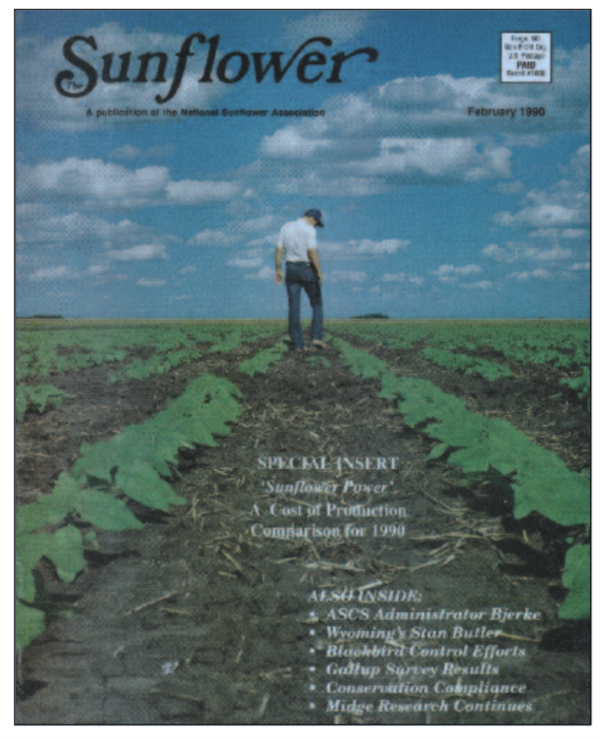Article Archives
30 Years Ago - A Look Back
Wednesday, January 29, 2020
filed under: Historical

Better Wheat Yields Via ’Flowers / By Don Lilleboe — “Sunflower has been paying its way for Wyoming grower Stan Butler since he began raising the crop in 1983. But what he really likes about ’flowers is what they do for his rotation — this in an area where a typical rotation without sunflower would boil down to simply wheat and summer fallow.
“ ‘Our average (oil-type sunflower yield) over the last five years has been 700-750 pounds,’ states the Carpenter, Wyo., dryland producer, adding that his 1989 crop hit the 1,000-pound level. ‘That’s good enough to pay the bills, but the big advantage is what it does for the wheat. We normally see a four- to five-bushel increase in our wheat yield on sunflower ground.’ One neighbor, he adds, contends that incorporating sunflower into his rotation has resulted in nearly a doubling of wheat yields.
“That’s no small consideration in this southeastern corner of Wyoming, where annual precipitation normally totals about 13 inches. Butler attributes sunflower’s impact on wheat yields to an increased soil mellowness. Following his initial year of sunflower production, he illustrates, ‘It was pretty dry that spring, and when I went in to plow, I had a hard time getting the plow in on my wheat stubble. But on my sunflower stubble, I hard a hard time keeping it out! There’s a lot of difference.’
“Butler says he hasn’t noticed an inordinate amount of soil moisture depletion by his sunflower for following wheat crops; quite the contrary. ‘I really think the sunflower ground better absorbs what moisture we do get,’ he remarks.”
Dovetailing Sunflower With Conservation Compliance / By Larry Kleingartner — “Conservation compliance, a notable requirement of the 1985 farm bill, sent shudders throughout a large portion of the western Dakotas upon becoming a reality. The area’s light soils and sloping landscape make it prone to soil erosion. Row crops are particularly suspect to erosion because of the limited crop residue left on the land following harvest. . . .
“Scranton, N.D., producer Bruce Freitag has a completed conservation plan that will continue to include sunflower. He says the requirements will alter slightly the way he treats the land following a sunflower crop. ‘Basically, I will be able to plant sunflower wherever I have before,’ the southwestern North Dakota grower explains. ‘I have some fields that I chose not to plant to sunflower in the past (out of) erosion concerns, and that will continue.’
“According to his conservation plan, Frietag will not till his sunflower stubble in the fall; nor will he till his fallow, which is his land treatment following sunflower. Instead, he will ‘chem fallow’ even though his plan does not specifically require this treatment. Depending upon the year, Frietag’s first chemical application (perhaps 2,4-D) will take place in June to kill the volunteer sunflower. Depending upon the weed situation, a LandMaster treatment to kill grassy weeds and kochia may be applied later. Again, Frietag does not plan to use any tillage until the following spring when he prepares the land for the succeeding wheat crop.
“The Bowman County grower will not make any changes in his program for preparing sunflower ground. He’ll make one fall tillage pass on the grain stubble while applying granular herbicide. This system will retain at least 50 percent of the grain crop residue on the soil surface. Frietag will make a single pass in the spring with a mulch finisher prior to planting his sunflower.”
Should the Midge Concern the Valley? / By Don Lilleboe — “It has five letters, but ‘midge’ was a four-letter word in the minds of numerous growers around the Red River Valley of North Dakota and Minnesota during the early 1980s. Damage from the sunflower midge cut many yields — and, in some cases, was a major reason for Valley farmers deleting sunflower from their rotation. Attempts at chemical control proved largely ineffective because of the insect’s inaccessibility on the budding sunflower head. Simultaneously, most commercial hybrids possessed little or no resistance to the midge.
“Both midge damage and ensuing newspaper headlines have virtually disappeared since then — in large part due to the steady decline in Red River Valley sunflower acres during the ’80s. Because it lost much of its habitat, the insect population itself retreated into near-oblivion, if not completely from the minds of producers who had contended with the troublesome creature.
“Given the real possibility of additional sunflower acres being planted in the Red River Valley in 1990 and future years, do Valley producers need to worry once again about the sunflower midge infesting and damaging their ’flowers?
“Not at present, believes Dr. Gary Brewer, research entomologist at North Dakota State University. Brewer does concede that ‘if we have a substantial increase in acreage, I would expect it to be followed, in a few years, by an increase in the midge population as well.’ But regardless of how many sunflower acres are in the Red River Valley in 1990 or 1991, he does not expect the insect to rebound quickly enough to cause serious problems.”
Mexican Government Selling Oil Mills — “The Mexican government’s oilseed processing plants have gone up for auction. The government owns four plants in the Mexico City vicinity accounting for about 15 percent of the nation’s crushing capacity. CONASUPO, the government’s agricultural commodity distribution agency, has received offers for its crushing plants and wheat mills from both Mexican and U.S. firms. The move is seen as an indication of the trade’s increasing importance. ?Still, final control of price and imports continues to rest with the Mexican government.”